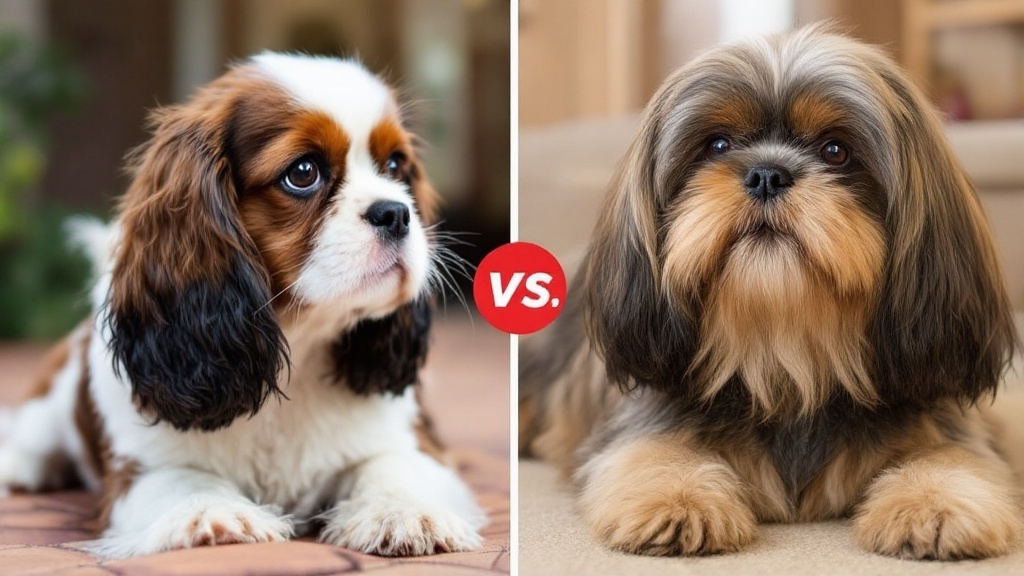Choosing between a Cavalier King Charles Spaniel and a Maltese really comes down to your lifestyle and what you want in a companion. Both breeds are fantastic pets, but the Cavalier tends to be more laid-back and a bit bigger, while the Maltese is tiny and usually has more pep.
Knowing these differences can help you pick the right dog for your home.
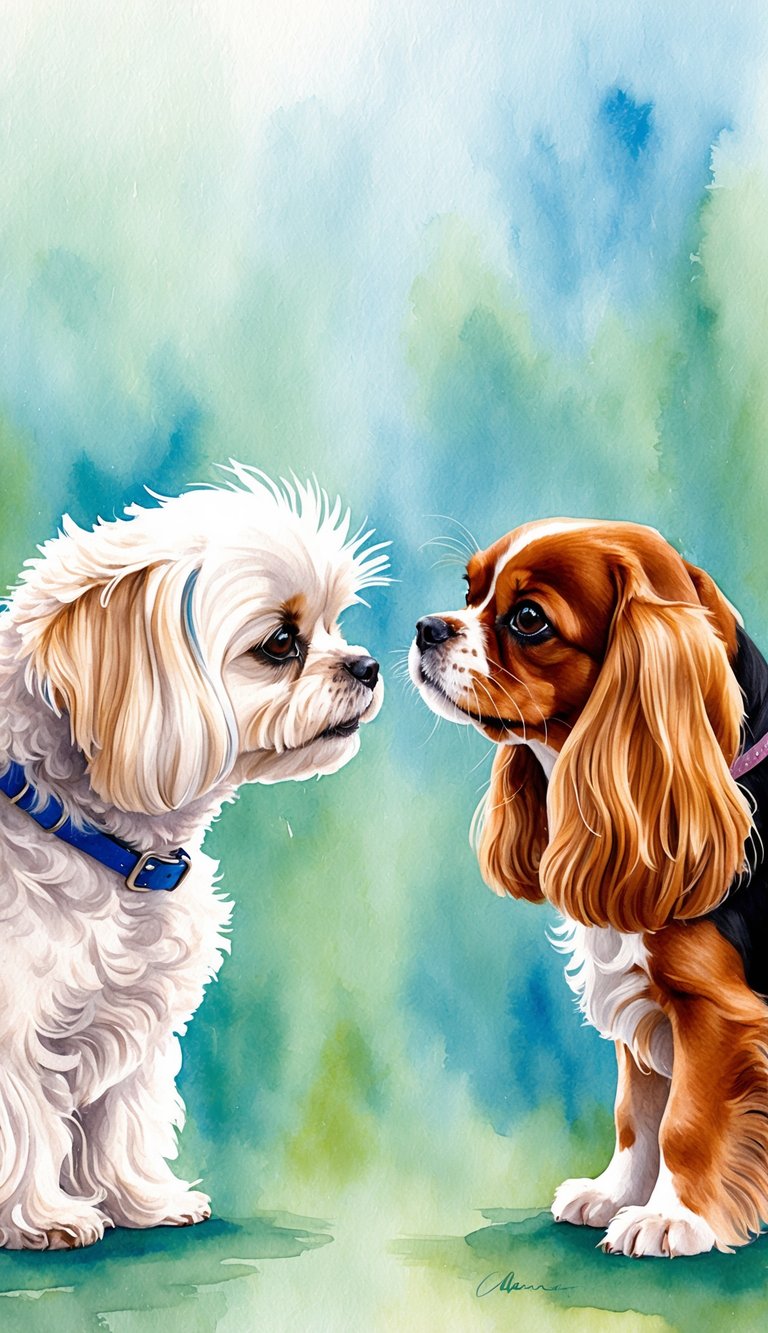
These dogs have their own distinct looks and personalities. Cavaliers have a silky coat that needs regular care.
Maltese dogs have a long, white coat that honestly demands daily grooming. Think about how much time you want to spend brushing and bathing—it’s not a small decision.
You’ll also want to consider energy and training. Cavaliers are usually easier to train and like moderate exercise.
Maltese can be a bit more stubborn, so they need more attention and patience. This comparison should help you figure out which breed fits you best.
Key Takeaways
- Each breed suits different homes based on size and energy.
- Grooming needs vary a lot between the two breeds.
- Training ease can affect how well the dog fits your routine.
Breed Origins and History
Let’s get into where these breeds come from and what they were bred for. Cavaliers and Maltese both have long histories as companion dogs, but their backgrounds are surprisingly different.
Knowing their past helps explain why they act the way they do today.
Cavalier King Charles Spaniel Background
The Cavalier King Charles Spaniel hails from England. King Charles II adored these small spaniels, and they became favorites in royal courts during the 17th century.
Cavaliers were bred to be gentle lap dogs. The breed almost vanished but made a comeback in the 20th century, thanks to dedicated breeders who wanted to restore their original look.
This gives them a mix of toy breed charm and a bit of working spaniel spirit. Read more on spaniel breeds.
Maltese Ancestry
The Maltese is ancient—one of the oldest toy breeds out there. Most believe it came from the Mediterranean, especially near Malta.
This breed’s history stretches back over 2,000 years. Ancient Greeks and Romans prized the Maltese for its tiny size and elegant coat.
It’s always been a tiny companion dog, mostly living with nobility and wealthy folks.
Historical Roles as Companion Animals
Both breeds were mainly kept as pets by the rich and royal. Cavaliers spent a lot of time in English palaces, keeping laps warm and company close.
The Maltese has long been a symbol of luxury, often found in the arms of high-status ladies. Both dogs reflect how much people have always valued small, affectionate companions.
That history still shows in their calm, loving personalities today.
Physical Appearance Comparison
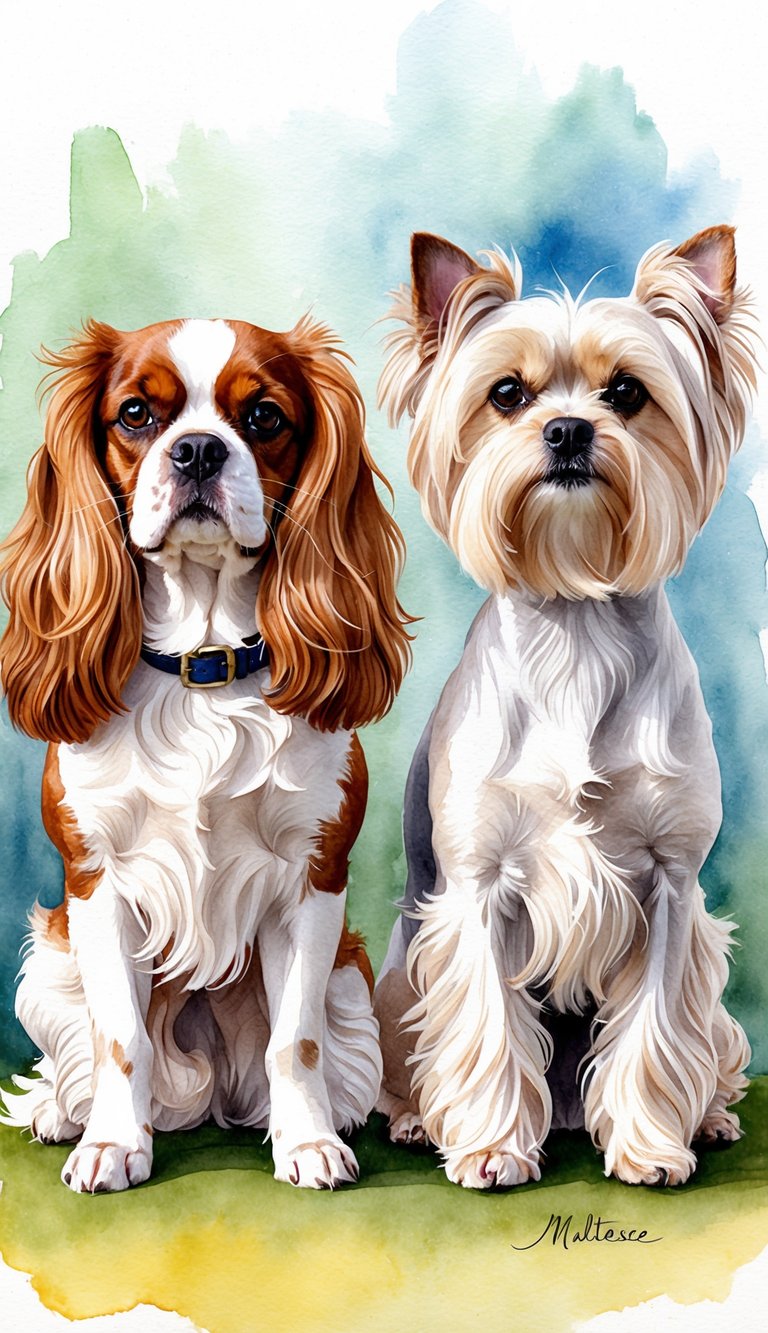
You’ll spot big differences in size, coat, and features between the Cavalier King Charles Spaniel and the Maltese. They’re both small, but each has a look all its own.
Size and Build
The Cavalier King Charles Spaniel is the bigger of the two. Most weigh 13 to 18 pounds and stand 12 to 13 inches at the shoulder.
They feel sturdy yet graceful, with a well-balanced build. The Maltese is much smaller—usually 4 to 7 pounds and just 7 to 9 inches high.
Its frame is delicate and feels lighter than the Cavalier’s. If you want a small dog that’s still sturdy, the Cavalier’s a strong choice.
For a dainty, feather-light little pet, the Maltese is the winner.
Coat Type and Color
Cavaliers have a medium-length, silky coat. It can be straight or a bit wavy, and you’ll need to brush it regularly to keep tangles away.
Common Cavalier colors include Blenheim (chestnut and white), Tricolor (black, white, and tan), Black and tan, and Ruby (solid red).
The Maltese coat is long, straight, and always white. It looks silky and can reach the ground if you don’t trim it.
Daily brushing is a must to avoid mats. Both breeds need grooming, but the Maltese is definitely more high-maintenance because of its long, pure white hair.
Distinctive Features
Cavaliers stand out with their big, dark eyes and long, wavy ears. Their faces are round with a gentle expression and a slightly tapered muzzle.
Maltese have small, round heads and dark, alert eyes. Their ears drop down, covered in feathery hair, and their black nose stands out against their white face.
The Cavalier looks more robust and expressive, while the Maltese appears dainty and refined. These features make it pretty easy to tell them apart at a glance.
Temperament and Personality Traits
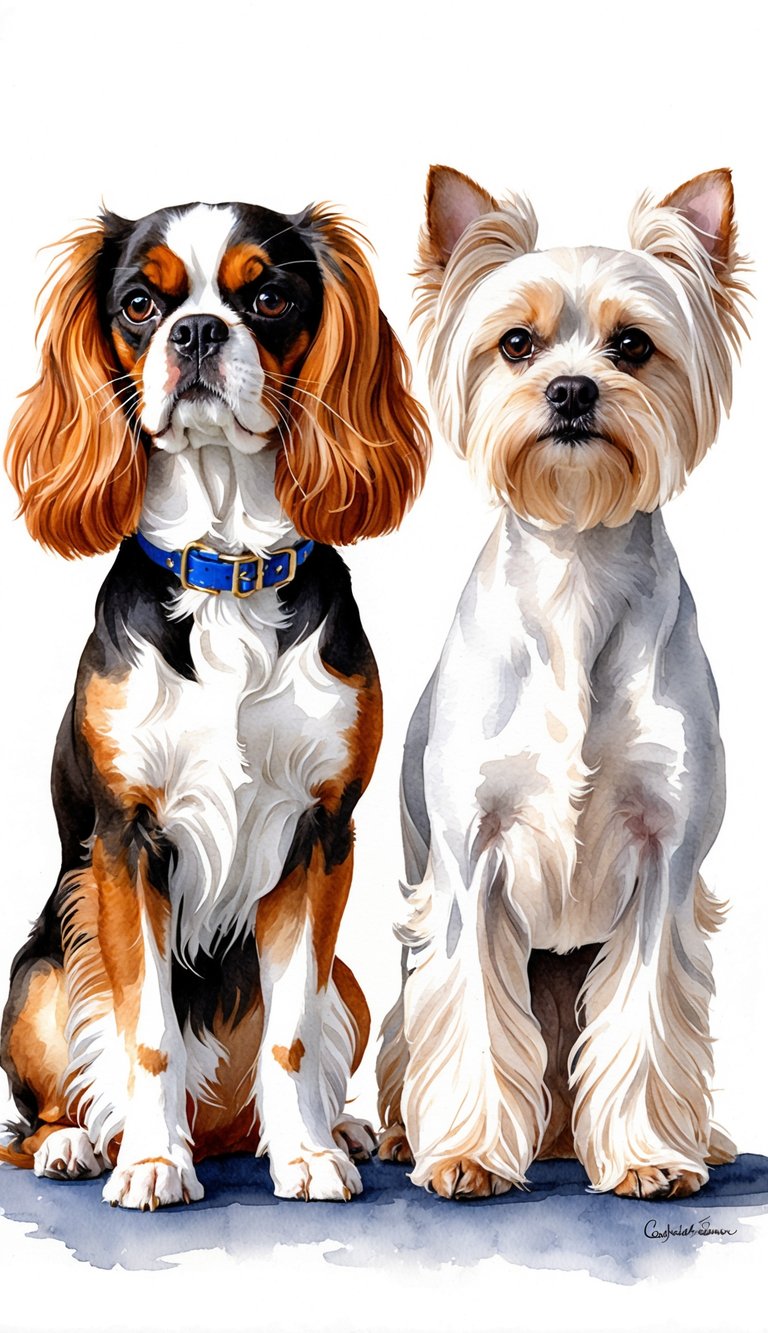
When it comes to personality, these two breeds have some real differences. Both make good pets, but their ways of showing affection and energy aren’t quite the same.
Behavioral Characteristics
Cavalier King Charles Spaniels are gentle and affectionate. They’re classic lap dogs who love sticking close and relaxing with you.
They’re smart and pretty easy to train. Cavaliers have a playful side, but they’re happiest just hanging out by your side.
Maltese dogs are also clever and loving, but they’re a bit more lively and alert. They like to cuddle, but you’ll notice they have more energy and might bark more.
That can matter if you’re in an apartment. Both breeds like routine and daily attention.
Interaction With Families
If you have kids or other pets, both breeds can fit in, but in their own ways. Cavaliers are patient and usually great with children and other animals.
They almost never show aggression, so they’re a safe bet for families. Maltese bond closely with their people but might not tolerate rough play as well.
They can act protective and sometimes get cautious around strangers. If you want a dog that’s a little more independent but still loyal, the Maltese could be right.
Comparison With Other Toy Breeds
Compared to toy breeds like Yorkshire Terriers, Pomeranians, and Shih Tzus, Cavaliers are calmer and less assertive. Yorkies and Poms tend to be louder and more opinionated.
The Maltese shares some traits with the Shih Tzu—alert and lively—but usually focuses more on you. Both breeds are smart and trainable, but they need clear, gentle guidance.
If you want a dog with the charm of a toy breed but less stubbornness, Cavaliers and Maltese are worth a look.
Trainability and Intelligence
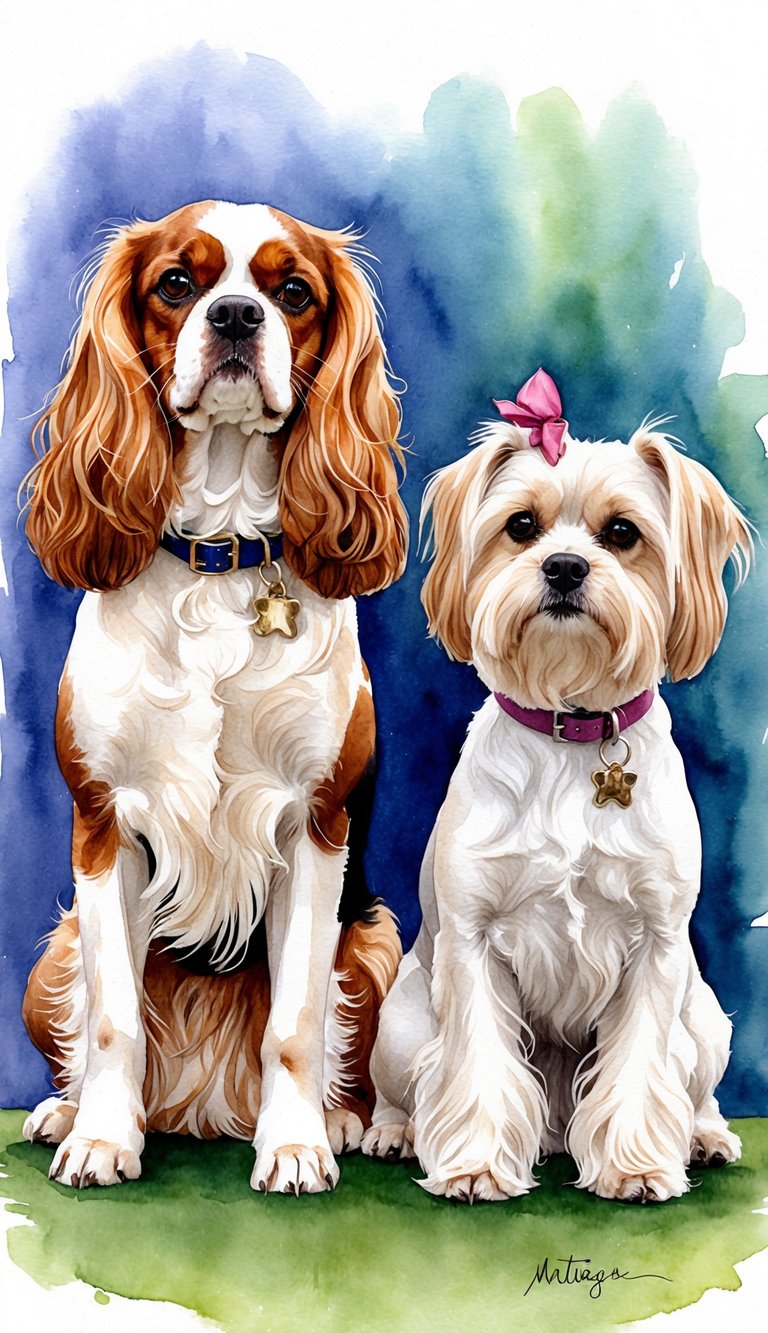
Both breeds are smart and pick up commands well, but their training styles aren’t identical. It helps to know how each one learns best.
Learning Speed and Methods
Cavaliers learn quickly when you use gentle repetition. They love praise and treats, and if you keep sessions short, they’ll pick up new skills fast.
They can get distracted, though, so keep lessons focused. Maltese are also quick learners and do well with positive reinforcement or clicker training.
They want to please you and often master basics in under two weeks if you practice daily.
| Breed | Learning Approach | Challenges |
|---|---|---|
| Cavalier King Charles | Gentle praise + treats | Gets distracted easily |
| Maltese | Positive reinforcement | Can be stubborn if bored |
Suitability for First-Time Owners
If you’re a first-time dog owner, either breed can work with some effort. Cavaliers are patient and forgiving, so mistakes aren’t a big deal.
They like calm, steady commands. Maltese need a firm but kind approach.
If you’re inconsistent, they’ll test you. But if you’re ready to put in the time, they’ll respond well.
Early socialization helps both breeds avoid stubborn habits. Cavaliers are a touch easier for beginners, but Maltese can be just as rewarding if you’re confident.
Exercise and Activity Requirements
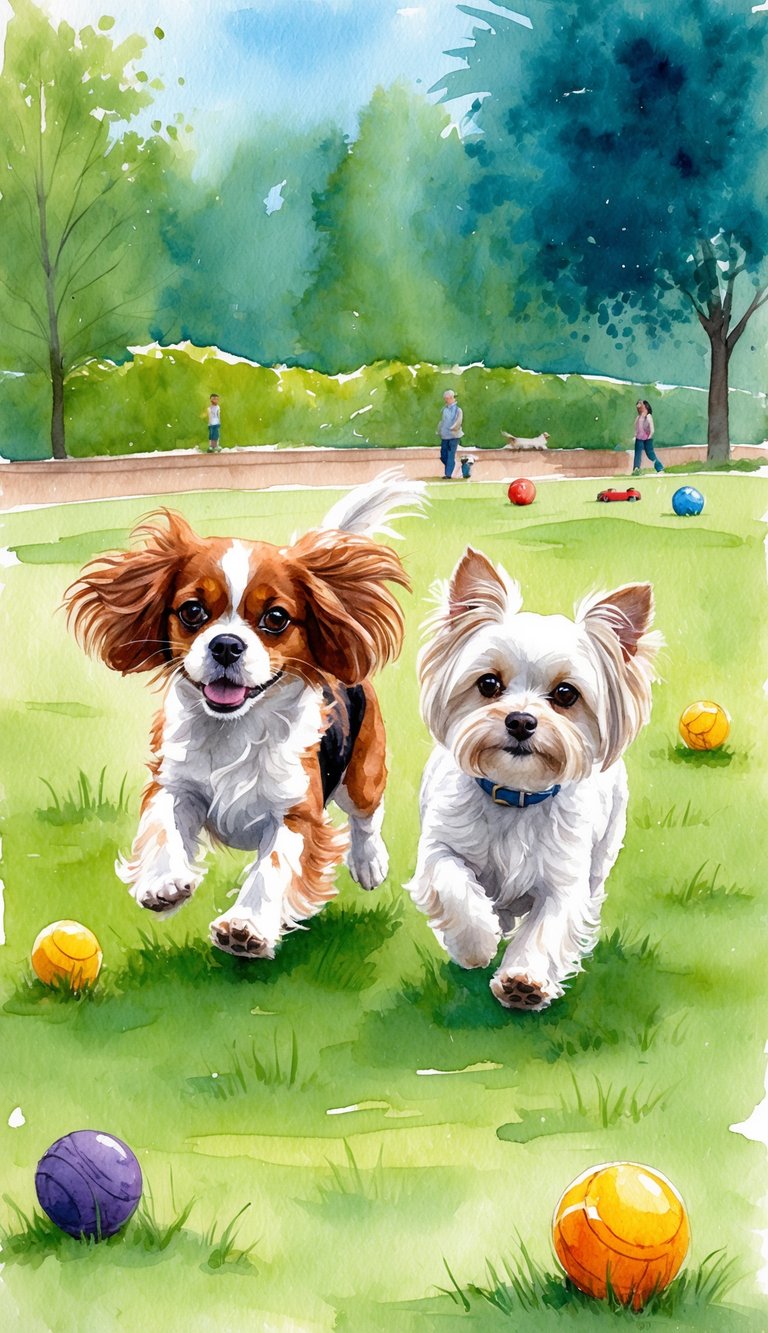
Both breeds need regular activity, but their exercise needs aren’t quite the same. Your daily habits and living space will really shape which one works for you.
Daily Exercise Needs
The Cavalier King Charles Spaniel does best with about 30 to 60 minutes of exercise a day. Walks, gentle play, or even some light running all work.
They love outdoor time but can handle apartment life if you keep up a daily routine. Maltese need less—about 20 to 30 minutes a day.
Short walks and indoor play are usually enough. They’re great in small spaces but still need daily movement to stay healthy.
Both breeds should avoid heavy exercise in hot weather. Stick to a steady routine for their health and happiness.
Playfulness and Energy Levels
Cavaliers are moderately active. They enjoy playtime but can also chill out with you for hours.
Their energy picks up during games, but they’re not hyper. Maltese dogs are lively and curious, with energy that comes in short bursts.
They get excited indoors and need mental stimulation to avoid boredom. Match play to their energy—Cavaliers are ideal if you want a calm but active buddy, while Maltese suit folks who like a spunky, energetic little dog.
Grooming and Maintenance

Your dog’s coat really determines how much grooming you’ll be doing. Both breeds look great, but each needs its own care routine.
Knowing what’s involved can help you stay on top of daily and weekly chores.
Coat Care and Shedding
The Cavalier King Charles Spaniel sports a medium-length, silky coat and sheds a fair amount. You’ll need to brush your Cavalier at least three times a week to prevent tangles and get rid of loose hair.
Pay special attention to their ears, since mats and debris love to collect there. Neglecting those floppy ears? That’s just asking for trouble.
The Maltese, on the other hand, has a long, fine coat that barely sheds—some people call it hypoallergenic. But don’t let that fool you; it matts up fast if you skip daily brushing.
You should brush your Maltese every day, focusing on tricky spots like the ears and tail. Their white coat shows dirt quickly, so you might find yourself wiping them down more often than you’d expect.
Both breeds need regular eye and face cleaning to keep tear stains at bay.
Grooming Needs by Breed
Cavaliers need brushing at least three times a week, and even more when they’re shedding heavily. A monthly bath keeps their coat clean, but don’t overdo it or you’ll strip away the natural oils.
Nail trimming and ear checks every two weeks are a smart routine. Skipping those can lead to problems you really don’t want.
Maltese owners, you’re signing up for daily brushing if you want to avoid mats. Many people opt for a short trim to make life easier.
Plan on baths every two to three weeks, depending on how messy your dog gets. Nail trims and teeth cleaning should be part of your regular care.
The Bichon Frise comes up in conversations about grooming, thanks to its curly coat. This breed often needs professional grooming every 4 to 6 weeks, which is a good reference point if you’re comparing maintenance levels.
Professional Grooming Recommendations
Professional grooming is a good idea for both breeds, but not at the same pace. Cavaliers usually need a trim every 8 to 12 weeks to keep things tidy and their ears in good shape.
For Maltese, professional grooming every 4 to 6 weeks is pretty standard. Groomers handle trims, ear cleaning, nail work, and those pesky tear stains.
If you want to keep a Maltese’s long coat looking good, regular pro help is almost a must. Make sure your groomer knows small breeds and handles them gently.
A good grooming routine keeps skin issues away and your dog feeling comfortable.
Health and Lifespan Considerations
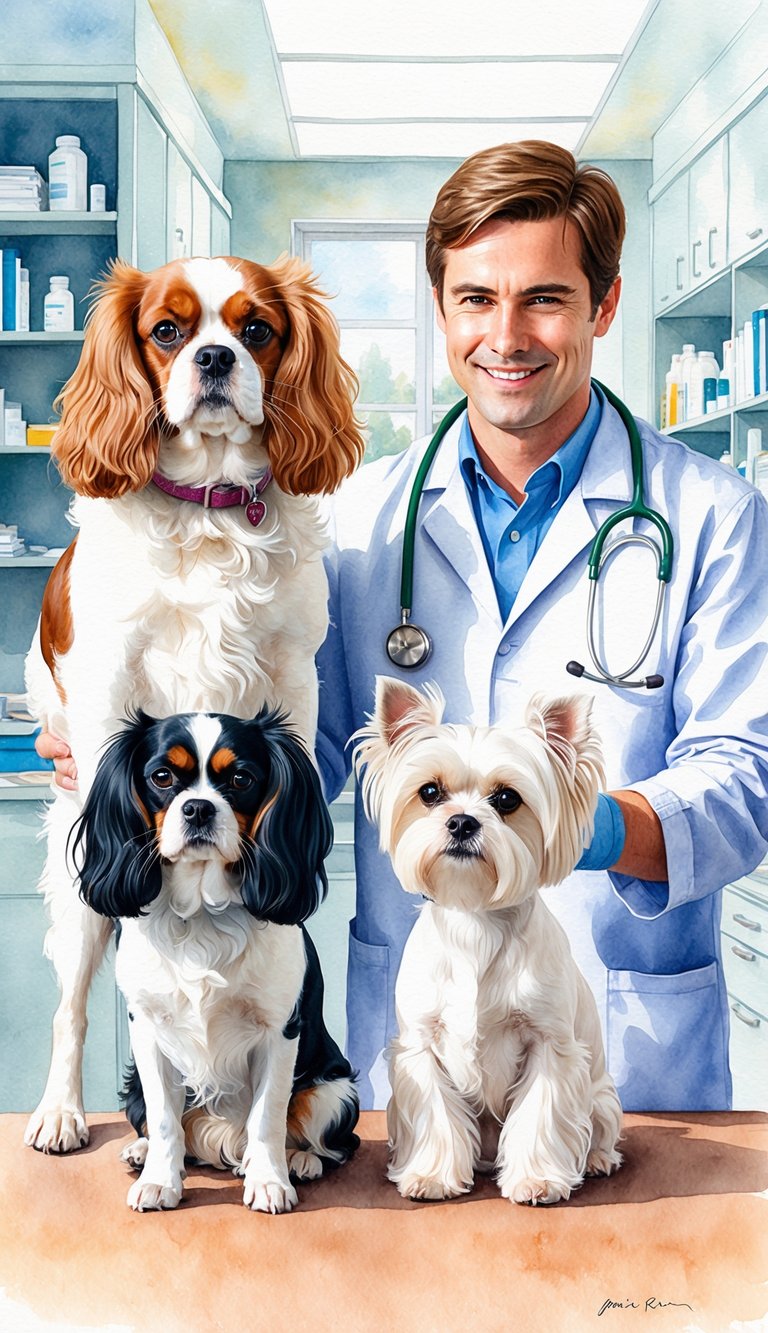
When you’re picking between a Cavalier King Charles Spaniel and a Maltese, it’s smart to look at their health issues and life expectancy. Both breeds have their own risks and quirks.
Common Breed-Specific Health Issues
Cavalier King Charles Spaniels often deal with syringomyelia, a painful neurological problem caused by fluid buildup in the spine. They’re also prone to mitral valve disease, which affects the heart.
Patellar luxation is another issue—basically, the kneecap slips out of place. It’s not fun for the dog or you.
Maltese dogs can get patellar luxation too. They’re also at risk for progressive retinal atrophy, which can lead to vision loss, and cataracts.
Corneal ulcers pop up sometimes because their eyes are so delicate. Regular vet checks catch these issues early.
Genetic Conditions
Both breeds come with some hereditary health risks. In Cavaliers, syringomyelia and mitral valve disease run in the family.
Knowing the health history of your dog’s parents and grandparents can make a real difference. Maltese dogs may inherit progressive retinal atrophy and luxating patella.
Genetic testing before you adopt or breed helps you pick healthy puppies and avoid passing along serious problems. Choosing reputable breeders and asking questions about family history lowers the odds of nasty surprises.
Preventive Care and Veterinary Visits
Frequent vet checkups are a must. Cavaliers need regular screenings for heart murmurs and signs of syringomyelia.
Eye exams catch cataracts or corneal ulcers before they get worse. Maltese need regular eye and joint exams too.
Your vet might suggest supplements or treatments to slow down retinal atrophy. Watch for limping or changes in vision.
Don’t forget the basics: vaccinations, dental care, and parasite control. Early detection and routine care help keep health issues in check.
Expected Lifespan
Cavalier King Charles Spaniels usually live 10 to 14 years. Heart and neurological problems can cut that short if you’re not on top of things.
Maltese dogs often make it to 12 to 15 years. Taking care of eye and joint problems early helps them stay healthy longer.
A dog’s lifespan really comes down to genetics, food, exercise, and how much you pay attention to their needs.
Diet and Nutritional Needs
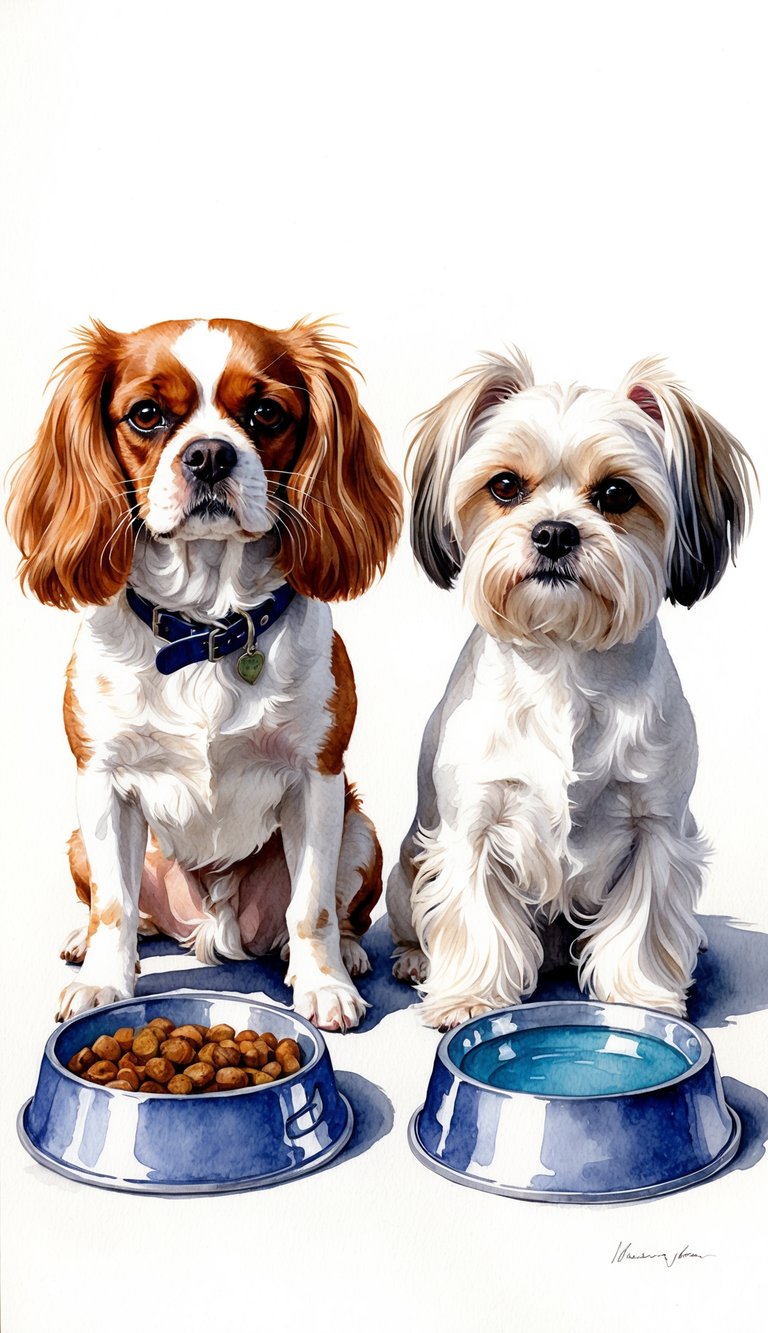
Both the Cavalier King Charles Spaniel and Maltese need diets packed with quality protein, healthy fats, and essential vitamins. Because they’re small, you’ve got to watch portions to prevent weight gain.
Recommended Diet for Each Breed
Cavalier King Charles Spaniels do best with moderate fat content in their food, matching their moderate activity level. High-quality proteins like chicken or fish are great, and omega-3s help keep their coats shiny.
The Maltese needs a nutrient-dense diet with easy-to-digest proteins. Their small stomachs and quick metabolism mean they do better with lean meats and frequent small meals.
Both breeds handle a mix of dry and wet food well, but skip fillers like corn or soy. Tossing in fresh veggies like carrots or green beans can add fiber and vitamins.
Weight Management
Weight gain sneaks up on both breeds if you’re not careful. Measure out their food and don’t go overboard with treats.
Cavaliers might need lower-calorie food if they’re not super active. Maltese need calorie-dense food, but in tiny amounts—obesity is a real risk.
Stick to regular exercise and keep an eye on portions. Using a body condition score chart helps you spot if your dog’s getting pudgy and adjust meals as needed.
Feeding Guidelines for Puppies and Adults
Puppies need to eat more often—usually three to four times a day—to fuel their growth and energy.
As they grow up, switch to two meals a day. Adjust portions based on age, activity, and metabolism.
Don’t change diets suddenly; transition over a week or so to avoid stomach issues. Always keep fresh water available, no matter your dog’s age.
Owner Suitability and Lifestyle Compatibility
Both breeds make great choices for folks who want a friendly, small companion. Picking the right one depends on your home and how you spend your days.
Ideal Living Environments
Cavalier King Charles Spaniels adapt well to homes with room for moderate exercise. Got a yard? They’ll love short play sessions.
They’re also fine in apartments, as long as you commit to regular walks. Maltese dogs fit perfectly into smaller spaces and don’t need as much room.
They’re happy indoors, but still want a daily walk to burn off energy and keep their minds busy. Whether you’re in a busy city or a quiet suburb, both breeds can adjust.
Cavaliers might suit you better if you love outdoor play. Maltese are a good pick if you’re more of an indoor person or don’t have much outdoor space.
Compatibility With Children and Other Pets
Cavaliers are gentle and patient with kids. They usually get along with other pets, including cats and dogs, making them a solid choice for multi-pet homes.
Maltese are good with children, but they’re a bit more sensitive and need gentle handling. They’re fine with other pets, but don’t always appreciate rough play.
If you’ve got young kids or other animals, think about your new dog’s temperament. Cavaliers can handle a little chaos, while Maltese thrive with calm, careful interaction.
Popularity and Pedigree Status
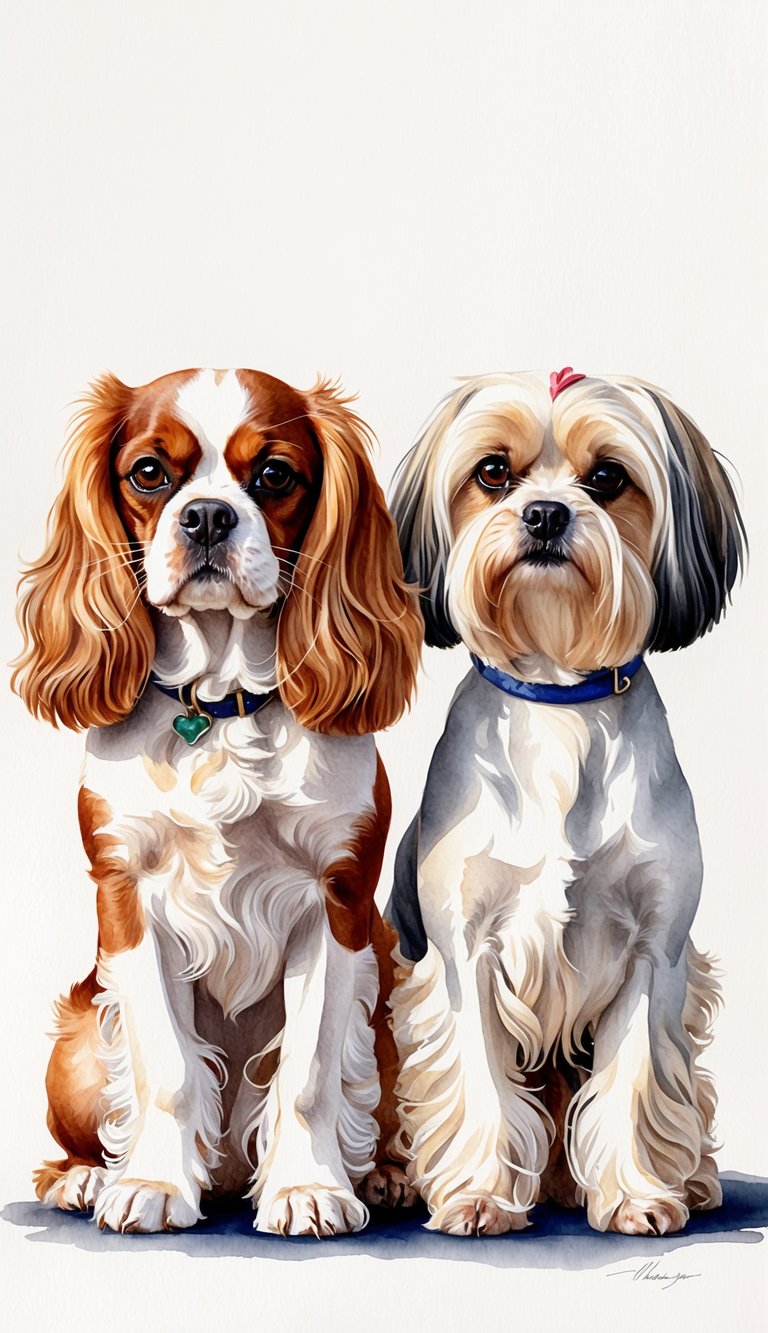
Both the Cavalier King Charles Spaniel and Maltese are famous toy breeds with loyal fans. Their popularity shifts a bit depending on where you look and what other small dogs are trending.
Popularity Among Toy Breeds
Cavalier King Charles Spaniels are pretty high up the list, thanks to their friendly vibe and good looks. They often compete with French Bulldogs and Pugs in the US and UK.
The Maltese has a steady following too, but usually ranks just below the Cavalier. Breeds like the Chihuahua and Papillon sometimes edge them out.
Both breeds attract people looking for affectionate, gentle pets. Cavaliers might appeal more if you want a slightly bigger toy breed, while Maltese are loved for their tiny size and bright white coats.
Popularity can change by region, but both breeds stay near the top of the toy dog world.
Recognition by Kennel Clubs
Both breeds are fully recognized by major kennel clubs, like the American Kennel Club (AKC) and The Kennel Club (UK). The AKC puts both the Cavalier King Charles Spaniel and Maltese in the Toy Group.
You’ll have no trouble finding pedigree registration for either breed, which makes finding a reputable breeder a bit easier. The Maltese boasts a long history as one of the oldest toy breeds, adding to its pedigree appeal.
The Cavalier’s royal background gives it a touch of prestige as well. Both breeds stick to strong show and breeding standards.
Comparisons With Similar Breeds
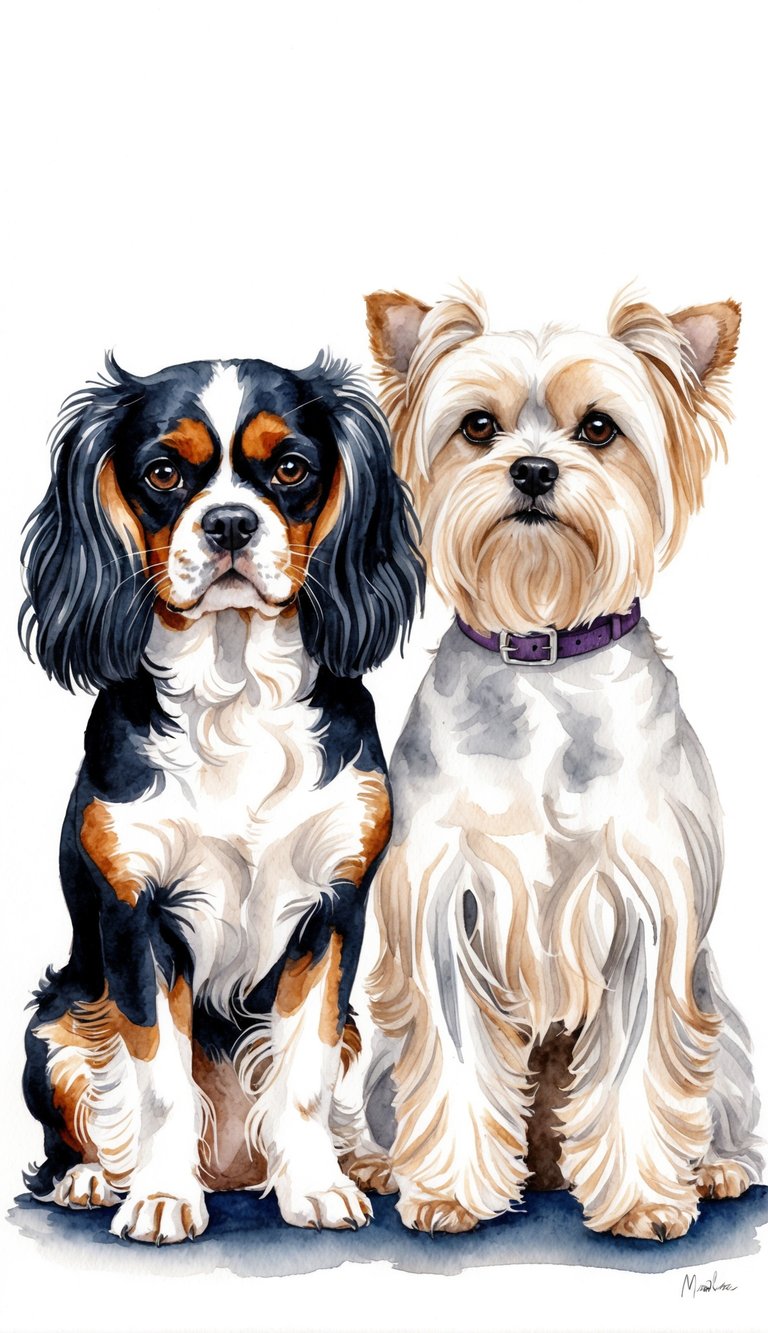
You might be curious about other small breeds that share traits with the Cavalier King Charles Spaniel and Maltese. There’s a lot of variety out there—some are more active, some need more grooming, and some just fit certain lifestyles better.
Shih Tzu vs. Toy Poodle vs. Bichon Frise
The Shih Tzu has a long, dense coat that needs daily grooming. It’s friendly but can be a bit stubborn compared to the Maltese.
Like the Maltese, the Shih Tzu is a devoted companion, but you’ll need patience for training. The Toy Poodle stands out for intelligence and energy.
Its curly, low-shedding coat is easier on allergies, but you’ll need to keep up with mental and physical activity. Compared to the Cavalier, Toy Poodles keep you on your toes.
The Bichon Frise brings a playful, cheerful attitude. Its fluffy, hypoallergenic coat needs regular trims.
It shares the Maltese’s friendly side, but packs a bit more energy—daily exercise is a must.
| Breed | Coat Type | Grooming Needs | Activity Level | Temperament |
|---|---|---|---|---|
| Shih Tzu | Long, dense | High | Moderate | Friendly, stubborn |
| Toy Poodle | Curly, low-shed | Moderate | High | Intelligent, active |
| Bichon Frise | Fluffy, hypoallergenic | High | Moderate-High | Playful, cheerful |
Pomeranian vs. Yorkshire Terrier
The Pomeranian has this wild, thick double coat that honestly needs a lot of brushing. If you skip a few days, mats show up fast.
It’s a tiny dog, but wow, it’s bold—always alert and lively, sometimes acting like it’s ten times its size. Pomeranians tend to bark more than Cavaliers, so if you like a quiet house, maybe think twice.
They’re usually a better fit for owners who want a playful, active companion.
The Yorkshire Terrier is small but definitely not shy. Its coat is silky and fine, so grooming feels like a never-ending project.
Yorkies are energetic and curious, kind of like the Maltese, but there’s a catch. If you don’t put in the work early on, they can get a bit bossy.
Both breeds make good watchdogs. But if you don’t socialize them, get ready for a lot of barking.
| Breed | Coat Type | Grooming | Energy Level | Temperament |
|---|---|---|---|---|
| Pomeranian | Thick double | High | High | Bold, vocal |
| Yorkshire Terrier | Silky, fine | Very High | High | Confident, bossy |
Other Small Breed Alternatives
If you’re considering other small breeds, you might want to look at the Miniature Pinscher, Silky Terrier, or the Chihuahua.
The Miniature Pinscher has loads of energy and really benefits from firm training. Its short coat is easy to manage, but this little dog can be pretty stubborn.
It’s not the cuddliest breed out there, though you’ll find it’s fiercely loyal.
The Silky Terrier sports a soft, shiny coat paired with a spunky attitude. Playful and always on alert, it needs a bit of grooming and likes to stay active.
Chihuahuas are tiny and come in both short and long-haired varieties. They’re bold, protective, and usually bond tightly with one person.
However, they’re not always as social as a Cavalier or Maltese.
Each of these breeds fits a different kind of owner, depending on your lifestyle and how much grooming you’re up for.


